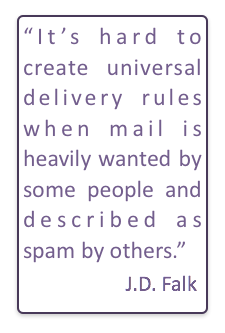Reputation is about behavior
- laura
- September 11, 2015
- Delivery improvement

Reputation is calculated based on actions. Send mail people want and like and interact with and get a good reputation. Send mail people don’t want and don’t like and don’t interact with and get a bad reputation.
Reputation is not
… about who the sender is.
… about legitimacy.
… about speech.
… about message.
Reputation is
… about sender behavior.
… about recipient behavior.
… about how wanted a particular mail is forecast to be.
… based on facts.
Reputation isn’t really that complicated, but there are a lot of different beliefs about reputation that seem to make it complicated.
The reputation of a sender can be different at different receivers.
Senders sometimes target domains differently. That means one receiver may see acceptable behavior but another receiver may see a completely different behavior.
Receivers sometimes have different standards. These include standards for what bad behavior is and how it is measured. They may also have different thresholds for things like complaints and bounces.
What this means is that delivery at one receiver has no impact on delivery at another. Just because ISP A delivers a particular mail to the inbox doesn’t mean that ISP B will accept the same mail. Each receiver has their own standards and sometimes senders need to tune mail for a specific receiver. One of my clients, for instance, tunes engagement filters based on the webmail domain in the email address. Webmail domain A needs a different level of engagement than webmail domain B.
Public reputation measures are based on data feeds.
There are multiple public sources where senders can check their reputation. Most of these sources depend on data feeds from receiver partners. Sometimes they curate and maintain their own data sources, often in the form of spamtrap feeds. But these public sources are only as good as their data analysis. Sometimes, they can show a good reputation where there isn’t one, or a bad reputation where there isn’t one.
Email reputation is composed of lots of different reputations.
Email reputation determines delivery. Getting to the inbox doesn’t mean sending from an IP with a good reputation. IP reputation is combined with domain reputation and content reputation to get the email reputation. IP reputation is often treated as the only valuable reputation because of the prevalence of IP based blocking. But there are SMTP level blocks against domains as well, often for phishing or virus links. Good IP reputation is necessary but not sufficient for good email delivery.
Reputation is about what a sender does, not about who a sender is.
Just because a company is a household name doesn’t mean their practices are good enough to make it to the inbox. Email is a meritocracy. Send mail that merits the inbox and it will get to recipients. Send email that doesn’t, and suffer the repercussions.
